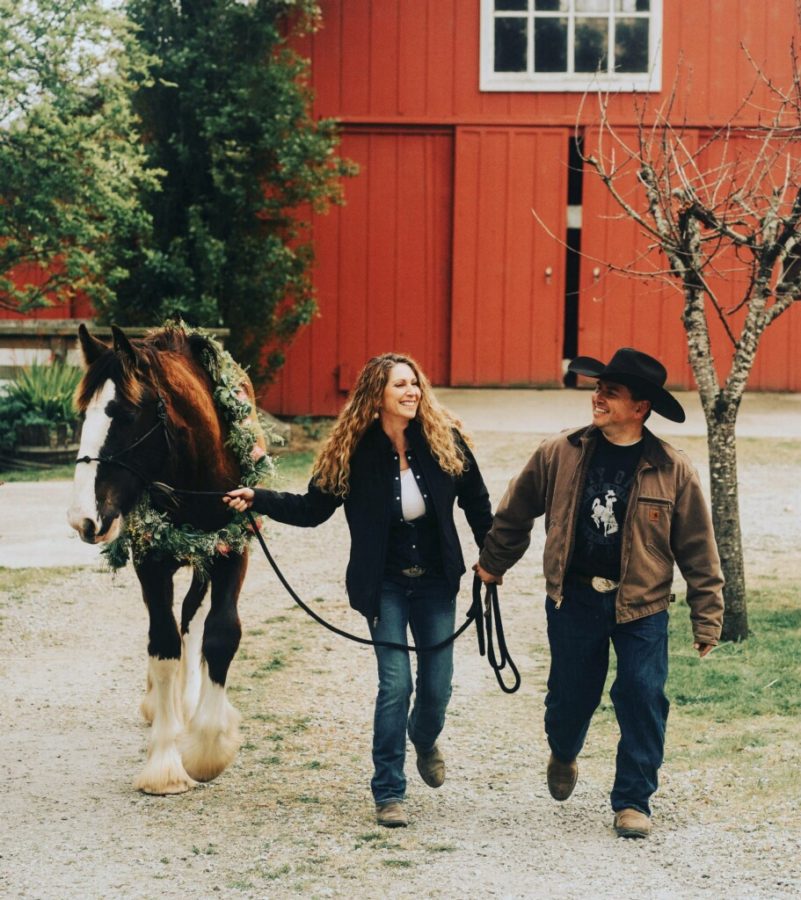New Menlo Spanish Teacher Reflects on Her Near-Death Experience
New Spanish teacher Patti Frias and husband Sal Frias walk with one of their horses on their 70-acre ranch. Photo courtesy of Patti Frias.
October 14, 2021
On Friday, June 20, 2008, new Menlo Spanish teacher Patti Frias was hiking Mount Shasta in Siskiyou, Calif. on a first date when the winds began to pick up, disorienting the couple. Frias and her now-husband, Sal Frias, were stuck on the mountain for three and a half days without food or water before they were able to find their way down.
“Sal and I met in Spanish class in high school, and then we went our separate ways,” Frias said. They reconnected 15 years later, when Frias and her sons lived in North Carolina, and he lived in the Bay Area. When they began talking again, they discovered that they both enjoyed hiking and decided to go on a hike for their first date. “So I flew out here, and we hiked Mount Shasta, and we ended up getting blown off the mountain,” Frias said. “And the only way we could find our way down was to go down the north face, which is the Whitney Glacier.” The Whitney Glacier is the longest glacier in California, according to the Mount Shasta Avalanche Center’s website.
“The last piece of food we had was one Starburst we split, and it was the best because we were so dehydrated,” Frias said. “We had no saliva, so we put the Starburst in our mouth and just kind of let it gather saliva, which was incredible.” The couple ran out of water and began hallucinating from a lack of oxygen and the freezing temperatures. “He and I really couldn’t communicate verbally because our mouths were so dry,” Frias said. Instead, Frias mimicked his movements. “When we had to traverse the glacier, it was just a sheet of ice,” Frias said. “If he put his ice ax and his crampon in, I would follow suit. Every step he took, I would step in his footsteps.” Because of this technique, the rescue team could only see a single set of footprints and originally believed Frias might have died. “They told my family there was a possibility that I had died,” Frias said.
Her two sons motivated her to continue trying to find her way down the mountain. “My son had just graduated high school, and on August 15, I was going to drive him to college,” Frias said. “I had to survive for my children.”
“We actually found our own way [down], even though they had Black Hawk [helicopters] looking for us, and over 100 volunteers were trying to find us but never could,” Frias said. They completed their journey down the mountain three days later when they reached a set of railroad tracks. “We came across a bear when we finally got to the train tracks,” Frias said. After a seven to eight mile walk, they found a lumberjack who helped them call 911, according to an ABC News article.
The connection they felt after their shared experience made their relationship strong from the start, according to Frias. “We thought, ‘Well we’re either gonna die together, or we’re gonna spend the rest of our lives together,’” Frias said. “And we chose to live.” Frias and her husband have now been married for almost 10 years. “It was wild, but here we are. We survived,” Frias said.
Now, the couple lives on 70 acres of land in Half Moon Bay. She has five dogs and three horses, a quarter horse, a shire mare and her baby. There are also about 23 cows on the ranch. They don’t own the cows, so they don’t have to feed or take care of them. “I don’t have any responsibility other than to play with them and hang out with them,” Frias said. However, she mucks the horses’ stalls twice a day, and has someone feed them and exercise them for her if she is unable to. “I try to go almost every day because it’s important to connect with them for my mental and physical stability, as well as for them to see me come and be consistent,” Frias said.
“Where I live is incredible,” Frias said. Her home is up in the mountains and very secluded. “There’s deer, and there’s 10 crazy wild turkeys that live on our land,” Frias said. There are also two miniature donkeys. Additionally, Frias and her husband love riding their horses. “We take the horses all the way from the ranch [to] downtown. Sometimes we’ll stop at Starbucks and get a Mocha,” Frias said. She also loves when her animals are a part of her community. “One of my horses was in the Half Moon Bay Fourth of July parade, so we like to be involved and include our animals whenever we can,” Frias said.
Frias also enjoys the time she gets to spend with her son Frankie Machado now that they work on the same campus. Machado is Menlo Middle School’s Academic Support Coordinator. “Every morning, I get to hear him say, ‘I love you, mom, have a good day!’ and I’m like, ‘I love you, be good!’” Frias said. Their dynamic reminds her of when he was in elementary through high school, but adjusted for their age. “Now we’re both professionals, and it’s great to be able to work with him and talk shop,” Frias said.
Machado loves having his mom work at Menlo. “When people ask me who my hero is, I always say my mom,” Machado said. He believes that she helped him become who he is today. “I consider her a mentor teacher, as she is one of the most experienced, knowledgeable and compassionate educators I know,” Machado said. “It is an absolute privilege and a blessing to be able to work alongside my mom here at Menlo.”
Before working at Menlo, Frias was an assistant principal at San Mateo High School. “Watching my son thrive here at Menlo has been incredible, and that’s a testament to the school and the leadership,” Frias said. “It’s because of him that I chose to make this transition back into the classroom.” While it was a big adjustment at first, she has now acclimated back into teaching. “I’m starting to get that teacher vibe again, which is really exciting,” Frias said.
Her favorite part of teaching again is working with her new students and colleagues. “Knowing that I get to be creative again and I get to create experiences for them that hopefully they’ll enjoy, I could spend hours and hours on that,” Frias said. Even grading is exciting to her. “I know, maybe I’m in the honeymoon stage,” Frias said. She also loves being able to collaborate with her colleagues, which she didn’t get to do as much as the assistant principal. “I’ve missed that,” Frias said, “I really feel like I’m right there with them, bouncing ideas and feedback around.”



